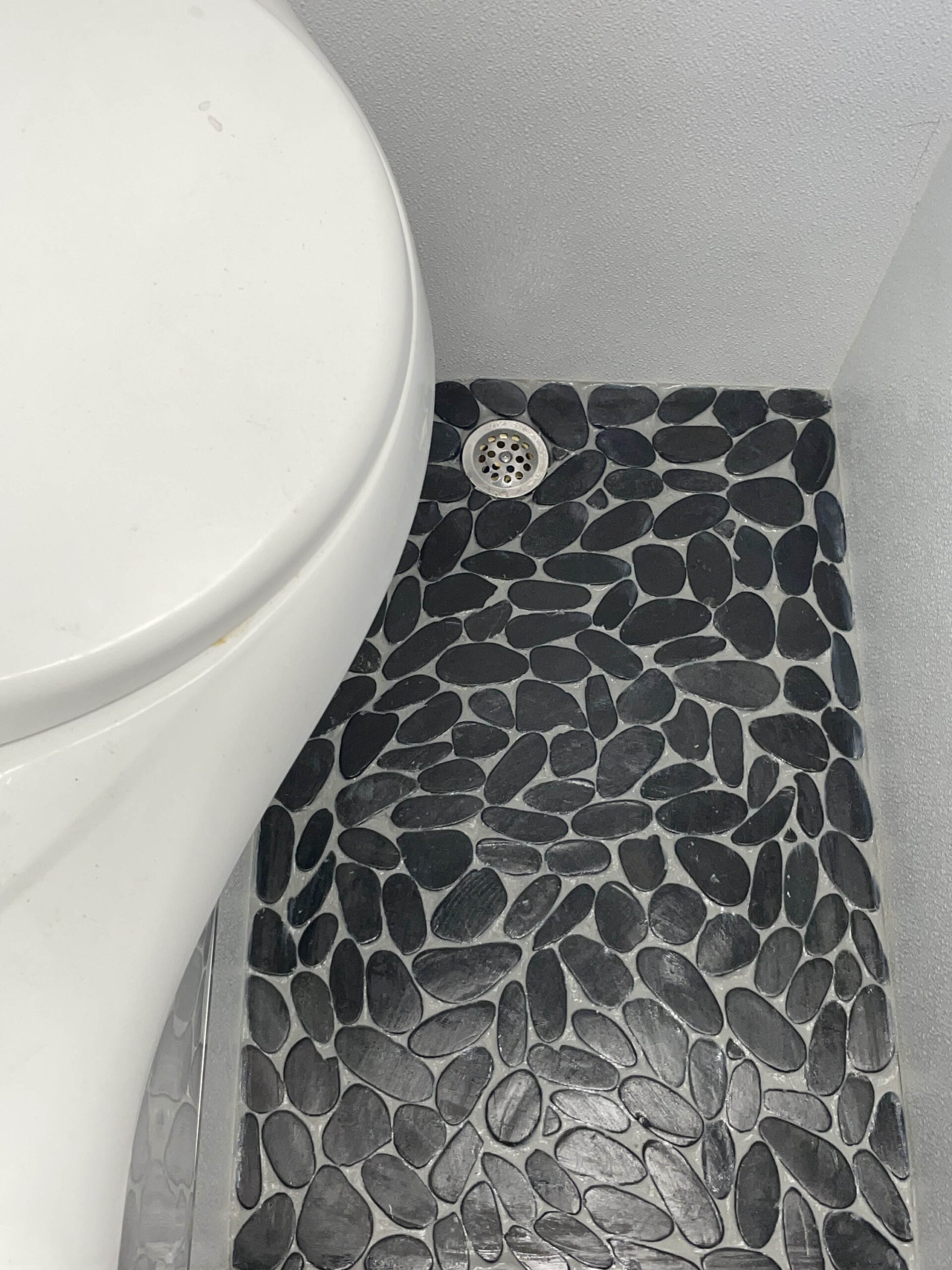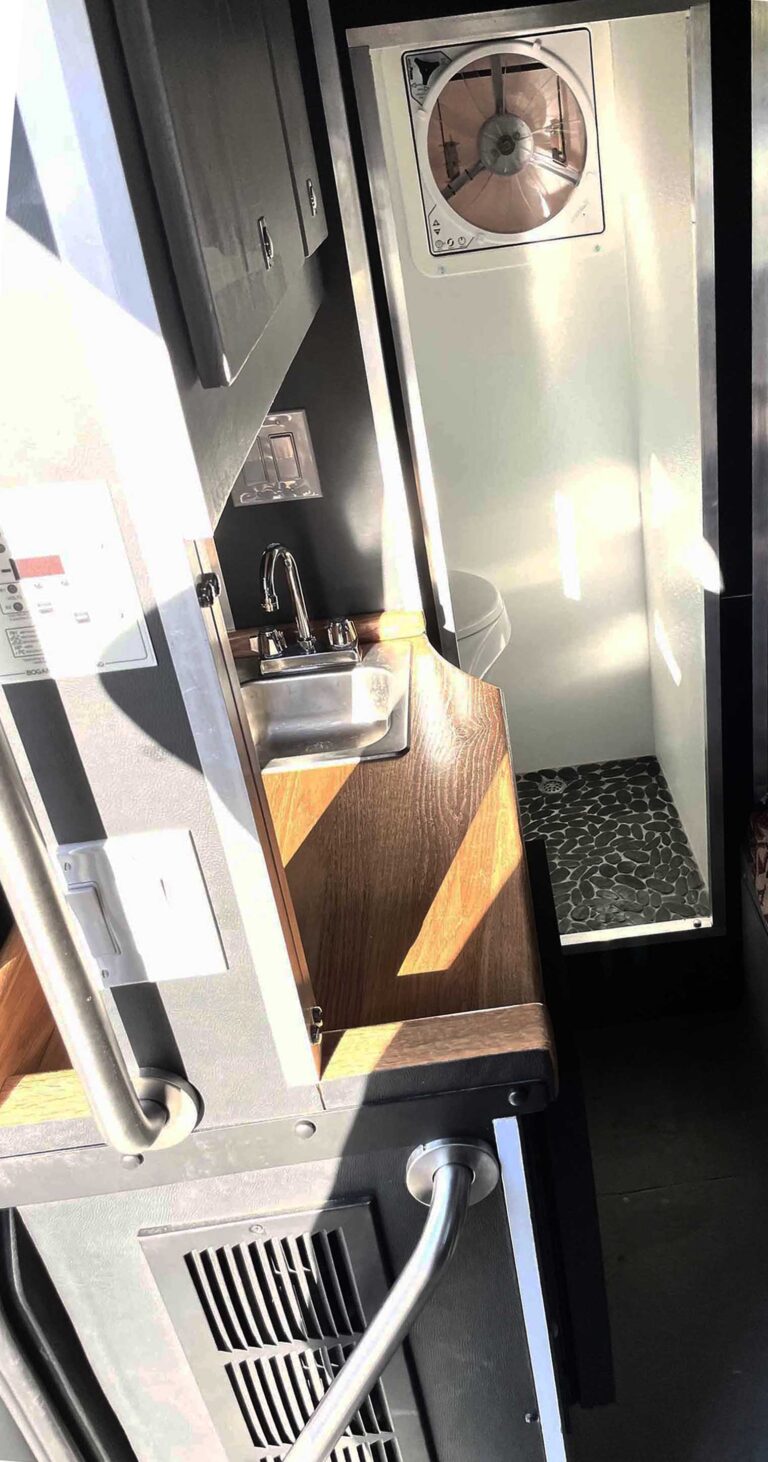Adding a SHOWER/TOILET COMBO in a Sprinter 144, specifically, a Thetford C402C toilet.
First off … if you are asking the opinion of people. As to whether an in-vehicle shower or toilet is necessary or desirable. Don’t go off those saying they would never sacrifice the space, would never want one, etc. Ask the crowd that has them, uses them, appreciates them. Some people don’t know what they are missing yet, never had them, really know nothing about them other than what they have read or heard. Yet they will try to convince you not to go this route.
If someone says it is because of moisture or humidity reasons. They don’t know what they are talking about. You can have this issue without a shower or toilet.
Most vent their RV for various reasons with Maxair or Fantastic fans. Even a simple roof vent. The humidity in parts of the country is often higher than anything you might generate for the time you shower. Just open an exterior door when you are done if need be. There are plenty of Class B motorhomes out there commercially built with showers/toilets.
Build what you want or desire. Not what someone else builds or desires.
The most important thing to consider, if you decide to go this route is. You don’t want anything that allows water to migrate into the van. Even accidentally. Special considerations and design may be necessary if adding kids, or semi-responsible adults for that matter. If you know they are often careless or don’t pay attention to their surroundings.
Construction techniques may be beyond some DIYers with limited experience and skillsets.
There are campgrounds along the California coast I have stayed at. That state you must be fully self-contained with holding tanks. Had I not been, I may have missed out on one of the best experiences I have ever had camping.
I am sure restrictions like these will only increase with time.
In a Sprinter 144. No matter the location. The fit is going to be tight and consume valuable interior space. Though our thoughts are, it is well worth serious consideration. I personally would not have a rig without it. If you can fit a toilet, you can fit a shower. Or vice versa.
Some of the other exterior methods that people buy gear for, also occupies space. Tents, portable water heaters, catch basins, etc.
Being a lifelong backpacker. I am very familiar with “roughing it”. Both in the toilet arena, as well as some type of shower. As rudimentary as some have been.
Graduating from backpacking and vehicle camping. I have been through just about every phase of how and where to poop and pee. From camping out of a vehicle using “WAG Bags” to 5-gallon buckets and WAG Bags, to port-a-potties in both the vehicle and small tents made just for that purpose. Even a luxury-class “A” Motorhome. My previous build was a Cargo Trailer Conversion with a 34×42 shower/toilet combo.
Getting up in the middle of a cold night and walking to a campground toilet is not my idea of fun anymore. Stepping out in the night and peeing on your campsite …. just wrong. But there are always the “inconsiderate of the next person”, that do that.
I could go into detail about how I rank the following in order of convenience, hazards like accidental dumps/leaking into vehicles, contending with urine separators, or carrying waste through the interior of your vehicle, etc. Some of these hazards increase with kids and dogs/cats. To save all of that rhetoric, I will just say I have seen and used them all. Here is my worst to best.
Shovel and a Hole in the woods
WAG Bags
Bucket with WAG bag (even kitty litter)
Port-a-pottie/Chemical Toilet
Composing Toilet
Fixed Cassette with exterior dump i.e., (Thetford C402C)
Flush/Flapper toilet into exterior mounted and vented holding tank
Showering is another journey through phases of convenience verses availability. I am not one that likes crawling into my sleeping bag or bedding dirty and sweaty. I can get by on a sponge bath for a few 24-hour periods Not against washing my hair with a cold jug of water to make it through another day.
But after about 3 days I want a shower. It can be in my rig, a campground, a truck stop, or any pay shower I find along the way. I have even resorted to using a shower that had no hot water.
I have used a solar bag shower out in the open wearing a swimsuit. Hung one in a shower tent I packed along in the vehicle, set up, then tear down. Sometimes this tent was taken down in the rain and put away wet. All less than desirable situations.
I have had a shower that hooked up to the exterior of various rigs. Sometimes creating a muddy mess where you stand. Unless you want to haul more gear. Often this comes with taking a shower in the cold. Creating mud people or dogs get into. Not feasible in a parking lot like a truck stop, rest stop, etc.
Some places do not allow outside showers. Or gray water on the ground. Posted that you must be self-contained. No discharging, etc.
I have used many campground showers. Free and Pay. Not all ideal or clean. I have waited in line. Or dug to come up with enough quarters. Those charging keep raising the rates.
Something inside a vehicle that needs set up and stashed away is an upgrade from some of the previous inconveniences. But a royal PIA for the most part. The first-time water leaks out into your vehicle, you are on the path to ruining your rig. If you have kids, even more so.
So, we are back to another list based on use and experience. From worst to best showers.
Sponge Bath – Gallon jug of water hair washing
Shower Tent with gravity shower (points for solar warm water)
Pressurized Exterior Rig shower with hot water
Public showers (Campground, Truck Stop, Pay, etc.)
Interior Rig shower that requires some set up/tear down
Properly Installed RV grade shower that drains into a holding tank
Where space is at a premium. An interior combo Shower/Toilet area can often serve dual purpose in the same footprint.
Further, this same footprint doing double duty, can serve a third duty. Especially with a shower drain available. This space can serve as a place to hang wet towels, wet clothing, wet raincoats, and wet or snowy footwear.
That said here is an example of a shower/toilet build in a Sprint 144 (2019). There are numerous construction options available. Select one that won’t leak. Prevents overflow if the drain plugs, etc. Commerical RVs have evolved to make up for many sins in the past. Some of those, even the base section might be available.
In my case I couldn’t find anything that would work in the space I had. Including the wheel well I had to incorporate. Or sacrifice more space.
My finished interior shower footprint is approximately 27 inches x 27 inches. (Thetford C402C) I am 6 ft and 225lb. It is a bit cramped but beats any alternative except going bigger, or installing a flush/flapper type into a exterior holding tank.
The bottom shower section or module (About 36 inches in height is all one-piece hand laid fiberglass. The frame is thin gauge welded steel tubing. To create a support for the Thetford, while at the same time elevating it to clear a wheel well. The bottom of the shower floor is reinforced with 3/4 plywood to prevent the fiberglass floor from ever cracking.
Note: Wood framing could be used. I do suggest gluing and screwing all wood joints to prevent squeaking. I weighed my intended wood framing, against the thin wall steel tubing and found out I could actually cut down on materials and weight to produce what I thought was comparable as equal structural support.
I have the knowledge and welding equipment to fabricate a steel skeleton. I would have preferred Aluminum. But I do not have the equipment to weld aluminum. So rather than pay someone, or upgrade equipment, I kept my costs down with the next best alternative for me.
I never compared renting equipment to weld aluminum. Costs there may approach having it done by a mobile welder visiting you on-site after you have everything cut, fitted, and ready to weld? Might be a couple of options worth exploring?
The bottom module is anchored to the van floor via vertical anchor bolts that were preinstalled. The module frame was drilled. Then the frame slipped onto the bolts. Locking nuts and washers secure the module frame to the floor. At this stage the fiberglass is finished outside the van before this lower module is anchored.
The upper module is also light gauge welded steel tubing. With 3/16 plywood interior skins. It is positioned on top of the bottom module. The two modules are bolted together.
The bottom module has the Thetford C402C installed onto the raw finished fiberglass. The remaining exposed raw fiberglass walls are covered with bonded on FRP panels.
The upper plywood is covered with bonded on FRP panels. These upper FRP panels are purposely installed to overhang the bottom FRP panels buy 3 inches to create a caulk-less overlap joint (Shingle effect). Which means you may have to shim out the upper plywood in its installation stage. You do not want this overlap joint to touch each other to rub and squeak when driving down the road. An air gap of 1/8 to 1/4 inch is ideal.
All FRP joints need sealed with high quality silicone caulk made for showers, etc.
In my install my floor was finished with real stone tile squares. But not with standard thin set and mortar. Those products in a vehicle will soon crack and delaminate due to vibrations and bouncing around.
My stone tile squares were laid using silicone products to install swimming pool tile. First a silicone pool tile adhesive. Then a silicone pool tile grout. Neither are an inexpensive product.
Working the silicone pool grout is done with acetone rather than water.
If these products are used. And I suggest small stone as seen in my photos. You will have tile and joints that have some flex to them Neither the tile nor the joints will crack. Tile like 1-inch squares could also be used. But say away from larger dimensional tile that will tend to crack over time.
The Thetford C4042 Toilet was selected because of its self-contained holding tank capacity. Also, for the fact the holding tank can be removed and dumped, all from the exterior. Avoiding typical leak and spill accidents often associated with cassette type toilets that have to be pulled or carried through the interior of a vehicle. This leak/dump hazard includes some composting types, or types that use urine separator collectors.

![]()



